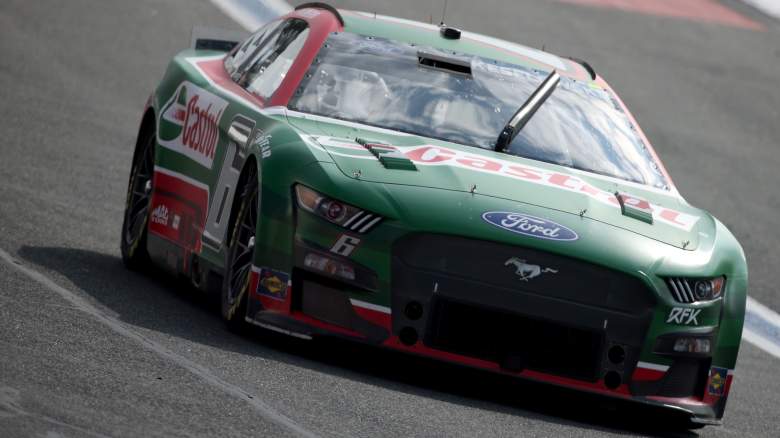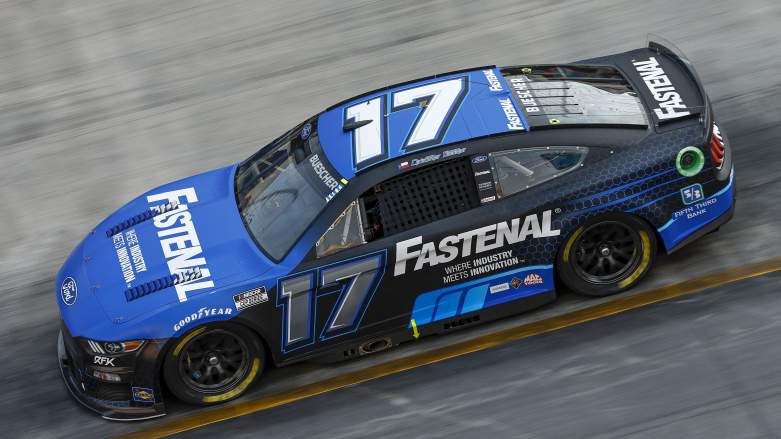
Getty Brad Keselowski races at the Charlotte Roval in October 2022.
Every single week, the NASCAR Cup Series teams show up with a wide variety of schemes. This is nothing new, but a big change that has taken place over several years is the move to vinyl wraps that require fewer hours of labor, a much cleaner shop, and some skills with a propane torch.
For RFK Racing, there are three main people in charge of the physical part of the operation. Jeff Silver is the manager of the graphics department, and he works with two shop employees that bring the designs to life every single week before Brad Keselowski and Chris Buescher head to the track.
NASCAR has changed significantly over the years, especially for those who work in the team shops. They no longer have to spend countless hours prepping and painting cars. Instead, they can quickly turn around the wraps in a matter of days, which helps them get a head start during crucial stretches of the season.
“Right now, especially with being able to print our own graphics in-house, we’re able to push [the wrap] closer to the date,” Silver told Heavy ahead of the trip to Homestead-Miami Speedway. “But you still need three or four days before the truck leaves. That would be pushing to be able to print the wrap to be installed and not interfere with the mechanics and setup guys.”
Silver and the crew try to wrap the cars roughly a week before they are needed. For example, the No. 17 and No. 6 Ford Mustangs were on the haulers heading to Homestead-Miami Speedway while the crew was wrapping the cars for Martinsville Speedway.
Wrapping cars removes countless hours of labor. It also ensures that the employees work in a much cleaner environment. This is a requirement considering that dust and other grime getting under the vinyl can cause it to fail.
This process has become far more streamlined for RFK Racing. The company recently purchased a printer, plotter, and laminator. This means that they can crank out wraps in-house instead of sending the designs out to a separate company and hoping that they show up ready for application.
Adding Some Extra Protection Onto the Wraps

GettyRFK Racing has showcased multiple Fastenal schemes over the years.
Wrapping cars is not a simple process, and there are many ways that the team can change the difficulty level. Chief among them is getting the right equipment for the jobs. There are different types of vinyl made by Avery Dennison, 3M, and Oracal among other companies. There are also different types of squeegees, vinyl rollers, knives, and tapes that have spots on the tool belt.
One key item that provides multiple benefits is the laminate. This clear film goes over the vinyl wrap after it comes off the printer and before it goes onto the cutter. The laminate provides UV protection. For long-term wraps, this means that the designs will take much longer to fade in the sunlight.
Additionally, wrap vinyl covered in a laminate reacts better to heat from a torch than unlaminated vinyl. It makes it easier to apply on cars, and it helps avoid crucial mistakes. This is particularly true when trying to use the torch to remove wrinkles from the vinyl. The laminate will help prevent accidental burn marks if the torch slips, and it will help the vinyl keep its shape.
Along with the application benefits and UV protection, the laminate serves a bigger purpose for RFK Racing and other race teams. The clear film can actually protect the wrap from damage throughout grueling races. It is less likely that some debris will tear up the design in the middle of a race.
“We do laminate for a couple of different reasons,” Silver said. “You know, it does add a little bit of weight. Don’t think it’s a lot. But just 500 miles at Darlington or Talladega, it’s pretty abrasive. The wrap needs to hold up until the end of the race, and they typically do.
“Also with the laminate, it keeps it from wiping away ink, that type of thing. It gives it some sort of protection. Throughout Saturday, qualifying on Sunday morning, there’s a lot of hands on the car. There’s a lot of cleaning that goes along with it. It just gives that extra protection.”
The Wrap Process Has Evolved Throughout Silver’s Career

GettyCarl Edwards’ Aflac car required a lot of work.
Silver has extensive experience working on multiple generations of cars. He first started working in NASCAR in 1996 as a “teardown guy” for Butch Mock Motorsports before becoming a tire specialist in 1999. One year later, he left BMM for Jack Roush’s team and got a job in the body shop.
Back in the early 2000s, teams weren’t incorporating vinyl wraps. They were painting the cars and then sticking some sponsor decals on top of the paint. Though this process slowly began to change right around Carl Edwards’ nine-win season.
“So probably in the late 2000s — 2008, 2009 — you started doing more and more with larger pieces of the decal,” Silver explained. “The paint schemes started evolving, and it just really didn’t make sense to spend a lot of time masking off and painting. Graphics got bigger, and as they got bigger, we started expanding into full wraps.
“And slowly the painting process pretty much died. It died a slow death. I was primarily a painter who worked in the body shop and could pretty much do everything.”
The move to full wraps saved a considerable amount of time for the shop employees, and it led to cleaner working conditions. However, there were still some moments when they had to apply body filler to certain parts of the cars and then cover it with primer paint before applying the wrap.
“I can remember, on the Aflac car, we used to actually mask off where the large green feather would go, so there was no paint underneath. So we were doing like half paint jobs, half vinyl. Then it just evolved to full wraps.”
This was especially true during the Gen 6 era, but the situation completely changed with the introduction of the Next Gen car. The bodies are no longer sheetmetal. They are now carbon fiber, and the teams just install the wraps on them without paint or body filler.
NASCAR actually made it against the rules to paint the Next Gen bodies before applying the wraps. The main reason is that the sanctioning body wanted the officials to be able to pull back any section of the vinyl during an inspection and make sure that there are no modifications that would bring about L1, L2, or L3-Level penalties.
A Lifetime of Lessons Leads To Success
Correctly installing decals on cars without bubbles, wrinkles, or other imperfections takes practice, a lot of patience, and occasionally, a great teacher. Perfectly wrapping a race car with complex curves and large bumpers is another matter entirely.
There are classes dedicated to the art of wrapping vehicles. Thousands of students take these multi-day courses every year while trying to learn as much as possible and become the best at the craft. They learn about the best vinyl types, the best tools, and the tips for getting rid of pesky wrinkles in trouble spots.
Silver didn’t take any of these courses as RFK Racing transitioned from painting to wraps. Instead, he gave “110%” every single day while learning on the go. He has since become a master of the craft after wrapping thousands of stock cars across various generations.
This includes the 2022 season, which will end with Silver and the RFK Racing crew wrapping “200-some cars.” The first year of the Next Gen era has been grueling even with the teams not having to paint or use body filler. Though Silver is not going to complain considering that he loves his career and the path it has taken.
“I mean, if I look back on my career, I was just a guy who was lucky enough, honestly, to know someone who worked in racing, which gave me the opportunity to go to work for a team,” Silver said. “And over the years, there have been a lot of long hours, a lot of sacrifices made.
“But when you see the cars on the track and know the opportunities that you have been given to do what you do, that feeling — I can’t describe it — but it’s just a blessing to have the job that I have and be able to do the things that I do. There’s a lot of long days — not as long as they used to be. It’s a lot cleaner than working at a body shop.
“I mean it’s a great feeling. Just working at RFK, especially now being given opportunities to take… Giving you the tools that you need with buying printers, cutters, and laminators. And being able to not only apply the wraps but be able to print them and go through that process. That’s why I get up at 3:30, 4 o’clock in the morning and come to work.”